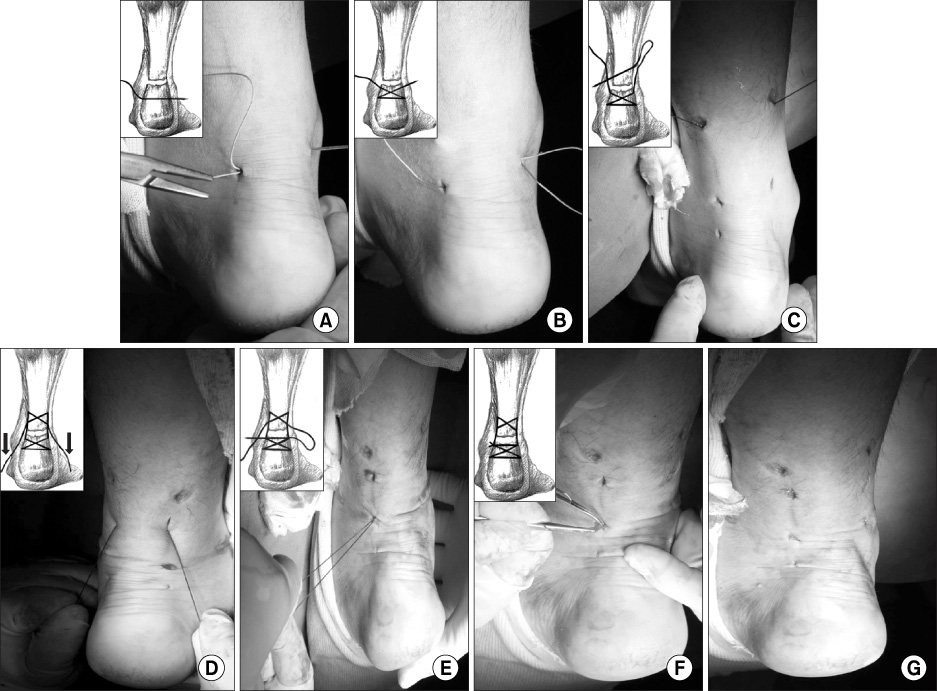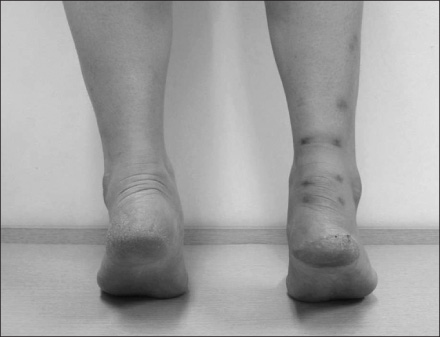J Korean Orthop Assoc.
2009 Dec;44(6):661-667. 10.4055/jkoa.2009.44.6.661.
Percutaneous Repair of Acute Achilles Tendon Ruptures
- Affiliations
-
- 1Department of Orthopedic Surgery, School of Medicine, Konyang University, Daejeon, Korea. sbkim@kyuh.co.kr
- KMID: 2186293
- DOI: http://doi.org/10.4055/jkoa.2009.44.6.661
Abstract
- PURPOSE
The purpose of the present study was to evaluate and analyze the clinical outcomes of the percutaneous repair of acute achilles tendon ruptures.
MATERIALS AND METHODS
We performed a retrospective study on 14 patients with acute closed rupture of the Achilles tendon and they were managed with percutaneous repair from Jan. 2006 to Jun. 2007. The clinical outcomes were analyzed according to the causes of the injury and the postoperative functional performances.
RESULTS
All the cases showed good or excellent outcomes, according to the Arner-Lindholm scale for the evaluation of acute Achilles tendon rupture. The average AOFAS score was 95.6 (range: 91-100). Nine patients were very satisfied and five patients were satisfied. They were satisfied especially because of the minimal postoperative scar. Two cases of sural nerve injury were reported as complications, and these cases fully recovered at postoperative three months. No evidence of surgical wound infection, necrosis of the wound or rerupture of the tendon was seen.
CONCLUSION
The percutaneous repair of acute Achilles tendon rupture achieved high functional outcomes, a successful return to previous work and high satisfaction, with a relatively low incidence of complications.
Keyword
MeSH Terms
Figure
Cited by 2 articles
-
Comparative Study of Clinical Outcome of Three Surgical Techniques in the Achilles Tendon Rupture: Open Repair, Percutaneous Repair, and Minimal Incision Repair by Achillon
Won Seok Park, Myoung Jin Lee, Jung Mo Kang, Seung Yup Lee
J Korean Foot Ankle Soc. 2018;22(2):68-73. doi: 10.14193/jkfas.2018.22.2.68.Minimal Invasive Surgery for Acute Achilles Tendon Rupture
Myoung Jin Lee, Min-Woo Kim
J Korean Foot Ankle Soc. 2021;25(2):76-79. doi: 10.14193/jkfas.2021.25.2.76.
Reference
-
1. Cetti R, Christensen SE, Ejsted R, Jensen NM, Jorgensen U. Operative versus nonoperative treatment of achilles tendon rupture. A prospective randomized study and review of the literature. Am J Sports Med. 1993. 21:791–799.2. Inglis AE, Sculco TP. Surgical repair of ruptures of the tendo Achillis. Clin Orthop Relat Res. 1981. 160–169.
Article3. Maffulli N. Rupture of the Achilles tendon. J Bone Joint Surg Am. 1999. 81:1019–1036.
Article4. Wills CA, Washburn S, Caiozzo V, Prietto CA. Achilles tendon rupture. A review of the literature comparing surgical versus nonsurgical treatment. Clin Orthop Relat Res. 1986. 207:156–163.5. Lo IK, Kirkley A, Nonweiler B, Kumbhare DA. Operative versus nonoperative treatment of acute achilles tendon ruptures: a quantitative review. Clin J Sport Med. 1997. 7:207–211.6. Carter TR, Fowler PJ, Blokker C. Functional postoperative treatment of Achilles tendon repair. Am J Sports Med. 1992. 20:459–462.
Article7. Kocher MS, Bishop J, Marshall R, Briggs KK, Hawkins RJ. Operative versus nonoperative management of acute Achilles tendon rupture: expected-value decision analysis. Am J Sports Med. 2002. 30:783–790.8. McComis GP, Nawoczenski DA, DeHaven KE. Functional bracing for rupture of the Achilles tendon. Clinical results and analysis of ground-reaction forces and temporal data. J Bone Joint Surg Am. 1997. 79:1799–1808.
Article9. Ma GW, Griffith TG. Percutaneous repair of acute closed ruptured achilles tendon: a new technique. Clin Orthop Relat Res. 1977. 128:247–255.10. Kosanović M, Cretnik A, Batista M. Subcutaneous suturing of the ruptured achilles tendon under local anaesthesia. Arch Orthop Trauma Surg. 1994. 113:177–179.
Article11. Hockenbury RT, Johns JC. A biomechanical in vitro comparison of open versus percutaneous repair of tendon achilles. Foot Ankle. 1990. 11:67–72.
Article12. Webb JM, Bannister GC. Percutaneous repair of the ruptured tendo achillis. J Bone Joint Surg Br. 1999. 81:877–880.
Article13. Cretnik A, Kosanovic M, Smrkolj V. Percutaneous versus open repair of the ruptured achilles tendon: a comparative study. Am J Sports Med. 2005. 33:1369–1379.14. Cretnik A, Zlajpah L, Smrkolj V, Kosanovic M. The strength of percutaneous methods of repair of the Achilles tendon: a biomechanical study. Med Sci Sports Exerc. 2000. 32:16–20.15. Kang CN, Kim JH, Kim DW, Koh YD, Go SH, Kim SM. Surgical Fepair of Achilles Tendon Ruptures: modified lindholm method. J Korean Orthop Assoc. 1997. 32:711–718.
Article16. Saxena A, Maffulli N, Nguyen A, Li A. Wound complications from surgeries pertaining to the Achilles tendon: an analysis of 219 surgeries. J Am Podiatr Med Assoc. 2008. 98:95–101.17. Winter E, Weise K, Weller S, Ambacher T. Surgical repair of achilles tendon rupture. Comparison of surgical with conservative treatment. Arch Orthop Trauma Surg. 1998. 117:364–367.18. Ceccarelli F, Berti L, Giuriati L, Romagnoli M, Giannini S. Percutaneous and minimally invasive techniques of achilles tendon repair. Clin Orthop Relat Res. 2007. 458:188–193.
Article19. Fortis AP, Dimas A, Lamprakis AA. Repair of achilles tendon rupture under endoscopic control. Arthroscopy. 2008. 24:683–688.
Article20. Tang KL, Thermann H, Dai G, Chen GX, Guo L, Yang L. Arthroscopically assisted percutaneous repair of fresh closed achilles tendon rupture by Kessler's suture. Am J Sports Med. 2007. 35:589–596.
Article21. Sutherland A, Maffulli N. A modified technique of percutaneous repair of ruptured achilles tendon. Oper Orthop Traumatol. 1998. 10:50–58.22. Gigante A, Moschini A, Verdenelli A, Del Torto M, Ulisse S, de Palma L. Open versus percutaneous repair in the treatment of acute achilles tendon rupture: a randomized prospective study. Knee Surg Sports Traumatol Arthrosc. 2008. 16:204–209.
Article23. Kakiuchi M. A combined open and percutaneous technique for repair of tendo Achillis. Comparison with open repair. J Bone Joint Surg Br. 1995. 77:60–63.
Article24. Jung HG, Paik HD. Surgical repair of achilles tendon rupture by minimal incision technique. J Korean Foot Ankle Soc. 2005. 9:173–178.25. Jung HG, Lee SC, Park HG, Kim KY, Kim MH. Acute achilles tendon rupture: -Isokinetic plantarflexion torque evaluation after Krackow suture technique-. J Korean Soc Foot Surg. 2002. 6:181–189.
- Full Text Links
- Actions
-
Cited
- CITED
-
- Close
- Share
- Similar articles
-
- Surgical Treatment of the Ruptured Achilles Tendon: A Comparative Study between Percutaneous and Open Repair
- A Comparative Study of Surgical Treatment Result in the Ruptured Achilles Tendon: Minimal Incision Percutaneous Repair and Open Repair
- Minimal Invasive Surgery for Acute Achilles Tendon Rupture
- Management of Postoperative Complications Following Surgical Repair of Achilles Tendon Rupture
- Long Term Result of Four Cases without a Staged Reconstruction of an Infected Achilles Tendon Following Repair



